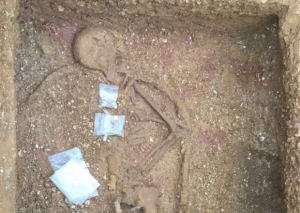Pocklington Post - 15th October 2015
 More than 150 skeletons have now been unearthed during an archeological dig in Pocklington, the Post can reveal. More than 150 skeletons have now been unearthed during an archeological dig in Pocklington, the Post can reveal.
The skeletons have been found at the recently discovered historical burial site on Burnby Lane, which is where developer David Wilson Homes is planning to build 77 new houses.
The site has so far yielded 156 skeletons and 76 square barrows.
Peter Morris, development director at David Wilson Homes, said: “To date we have discovered 156 skeletons, which is simply a continuation of the archaeological investigation works. Currently these skeletons are being taken away for analysis, which can take some time. We’re working extremely closely with the archaeologists at the site to ensure these discoveries are preserved and can help to cast light on our ancestors’ way of life. As with the presentation earlier this year at the Pocklington Arts Centre we hope to share the updated findings with the local community once on-site archaeological works are complete.”
Some of the square barrows contain personal possessions, including jewellery, and a sword has been found in one. Archaeologists have also discovered a skeleton with a shield.
It is believed the site dates to the Iron Age. which in Britain lasted from 800 BC until the time of the Roman conquest, which started in AD 43.
Paula Ware, managing director at MAP Archaeological Practice, the company which is carrying out the excavation work, added: “We have excavated 156 inhumations to date, which are being analysed at the present time. Finds have included several brooches and rings, in addition to over 300 amber and glass beads. Unfortunately, it is still too early to give a definitive description of the site at this stage, the completion date of the dig or where the findings will be displayed, as the post excavation process has only just commenced.”
Meanwhile, the Post understands that more ancient discoveries have been unearthed by archaeologists at a different site in Pocklington, as revealed in last week’s paper. Interesting finds are believed to have been uncovered during trial trenching on land north of Mile End Park, which has been allocated for housing development in the East Riding Local Plan (policy POC-C).
Evidence from aerial photographs indicate the presence of a former late Iron Age/Romano British settlement and square burial barrows running in an east-west direction across the central section of the proposed development site.
|

